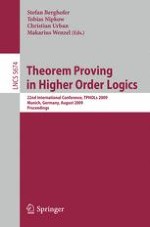This book constitutes the refereed proceedings of the 22nd International Conference on Theorem Proving in Higher Order Logics, TPHOLs 200, held in Munich, Germany, in August 2009. The 26 revised full papers presented together with 1 proof pearl, 4 tool presentations, and 3 invited papers were carefully reviewed and selected from 55 submissions. The papers cover all aspects of theorem proving in higher order logics as well as related topics in theorem proving and verification such as formal semantics of specification, modeling, and programming languages, specification and verification of hardware and software, formalization of mathematical theories, advances in theorem prover technology, as well as industrial application of theorem provers.
